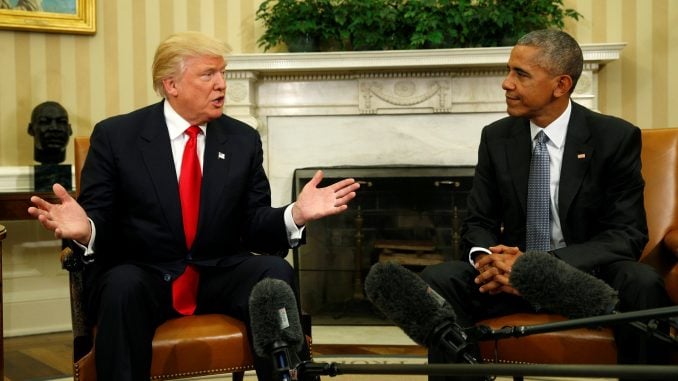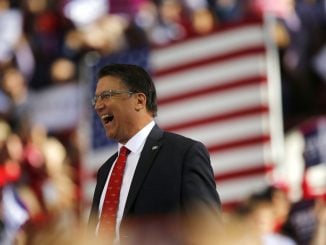
WASHINGTON, D.C. President-elect Donald Trump, his family and Vice President-elect Mike Pence spent the week in Washington meeting with Capitol Hill leadership and President Barack Obama. Melania Trump and Michelle Obama met to talk about raising children in the White House. The meetings were reportedly cordial and aimed at a smooth transition of power after a tumultuous election year.”It was a great honor being with you and I look forward to being with you many, many more times in the future,” Trump said after a meeting with Obama in the Oval Office.”We now are going to want to do everything we can to help you succeed because if you succeed, then the country succeeds,” Obama said, adding he and Trump discussed a range of domestic and foreign policy issues and details related to the transition period.Trump has been working on assembling his transition team, which is led by N.J. Gov. Chris Christie.Trump’s first 100 days was outlined during his campaign, promising to shake up a Washington establishment he said was responsible for destroying middle class jobs with bad trade deals. His message hit home across rural America and mid-sized cities, where voters felt they missed out on the fruits of the seven-year economic recovery that big cities may have enjoyed.Among the items on Trump’s to-do list are reportedly a limited repeal of the 2010 Dodd-Frank Act in addition to goals outlined during the campaign. Goldman Sachs CEO Lloyd Blankfein said Wednesday that Trump’s stated commitment to infrastructure spending, government reform and tax reform “will be good for growth, and therefore, will be good for our clients and for our firm.”Trump won 76 of N.C.’s â¨100 countiesWhile North Carolina went for Republican Mitt Romney in 2012, it was widely thought to be up for grabs in 2016. N.C. ended up being among the states that had an energized Trump’s base of disaffected, conservative-leaning voters. Trump’s message clearly resonated in the state, bucking polls that regularly showed Clinton ahead. RealClearPolitics is one of the few polling groups that identified Trump with a lead in N.C., estimating it at 0.8 percent before Nov. 8. He ended up winning the state by 3.8 percent.”I think it’s going to take a long time and a lot of research into what the exact causes where. Is it that there were a lot of candidates, is it that people who supported Trump just didn’t pick up the phone at all, and the non-response bias mattered?” said David Byer of RealClearPolitics. “Every election gives us new info that helps us figure out better what’s going on and allows us opportunities to improve.”Some say most poll results may have skewed too urban. For example, Charlotte has been growing fast as a financial hub that attracts college-educated talent from around the country, and Democratic nominee Hillary Clinton did better there than Obama did in 2012, beating Trump by 137,000 votes.But in the state’s textile and furniture belt just northwest of Charlotte, Trump’s promise of economic renewal and anxieties of a shrinking middle class more than offset Clinton’s urban victory. The Catawaba County region, one of the nation’s hardest-hit by imports from China, now has a more diverse economy and even the furniture industry has begun adding jobs. But many still live in poverty and rely on disability and social services for support.In Gates County, Trump’s vows to crack down on illegal immigration and police Muslim communities for radicalism resonated, said Eric J. Earhart, 49, pastor of the evangelical Upper Room Assembly church. “There has been a definite shift over the past eight years away from us being a Judeo-Christian nation,” Earhart adds, and many congregants worry about that.The rural county of 12,000 people went for Obama in 2012 with 52 percent of the vote, but it flipped into Trump’s column in this year’s race, giving him 53 percent.”The trade argument was as prominent as any. That is certainly the bet that the Trump campaign made,” said John Dinan, a political scientist at Wake Forest University.Election reactionSince Tuesday’s election, anti-Trump demonstrators filled streets of eight cities including New York, Washington, Los Angeles and Portland, Ore. The crowds were diverse in their ethnic makeup and largely consisted of young adults and college students. Some simply shouted and waved anti-Trump signs, others turned to vandalizing property. The crowd in Portland filled streets, spray-painted on buildings and broke storefront windows.”We’re here to bring to Donald Trump’s attention that we don’t support his rhetoric,” said Mark Patro, 60, marching on Baltimore Wednesday with his partner, Yanni Stavropoulos, 39. “We intend to resist, and I believe that resistance will continue for many Americans throughout his presidency.”As Trump prepares to take office, his team is working on his Contract with the American Voter, delivered in Gettysburg, Pa., in October. It outlines his plan for the first 100 days in office which he says will fulfill his campaign promises that so many American voters embraced.



